Oman is a country of incredible and contrasting landscapes, from majestic desert dunes and towering mountains to lush valleys zigzagging down to the wildlife rich coastline. It is destination full of surprises. But it’s the wadis in Oman that have stollen our hearts and have become quite an obsession.
Shaped by the force of nature over millennia, each wadi comes with its own unique character, challenges and highlights.
Some wadis are accessible and family-friendly, while others present the opportunity for real adventure.
In this guide to wadis in Oman I’m sharing the places we have visited with our kids, and with and without our family dog. All the pictures are my own.
I hope it gives you some inspiration and useful information for your own adventures in Oman.
What is a wadi?
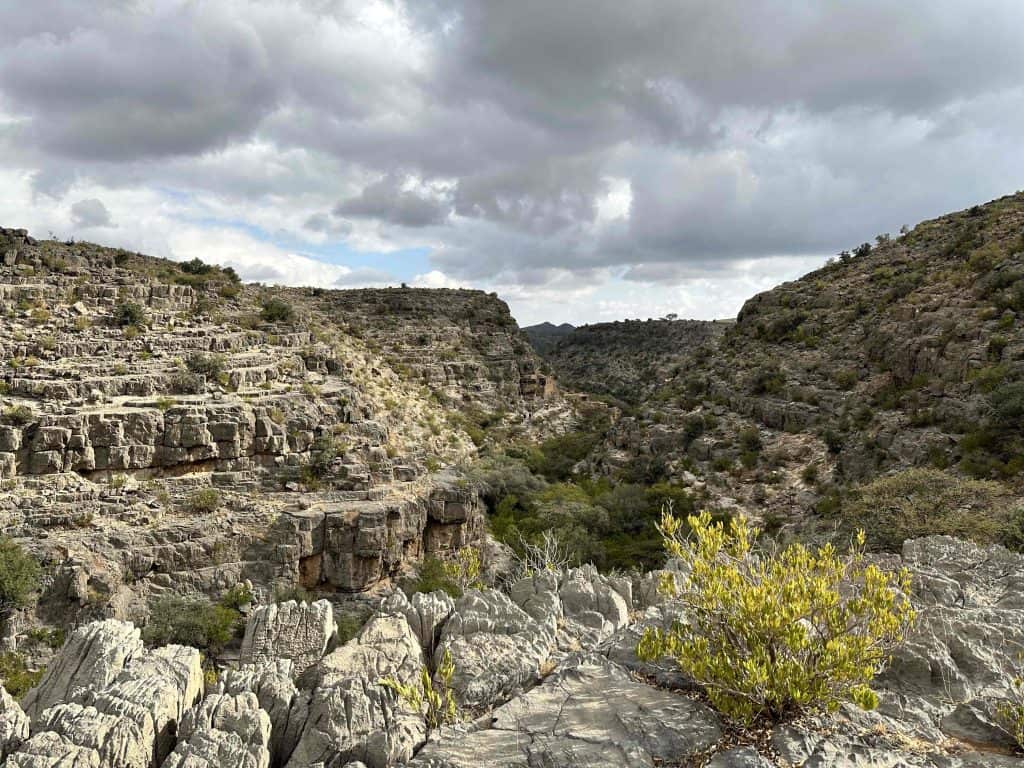
If you’re new to travel in Oman and the Middle East I wouldn’t blame you for wondering ‘what is a wadi?’.
Before moving here I don’t think I really appreciated what they were.
‘Wadi’ comes from the Arabic word ‘wādī’ which means valley.
They come in all shapes and sizes, but essentially they are a valley that can flood.
Wadis can have rivers running through them making them a lush oasis in the rocky landscape all year round. And they can be dry river beds or gullies that only flood during the rainy season.
They can have caves, dams, incredible geology and hot springs.
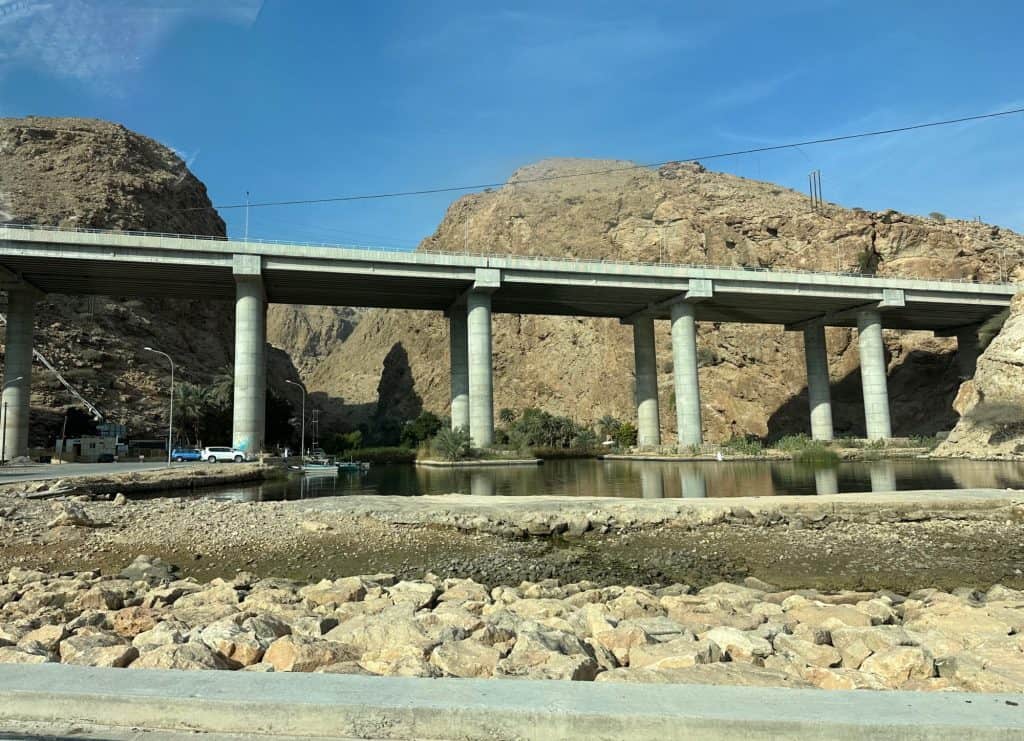
Wadis can start their life as deep canyons high in the mountains and end up as shallow outlets into the sea.
Every time we drive through Oman’s capital, Muscat, we cross several bridges over dry wadis in the latter stages of their meandering journey.
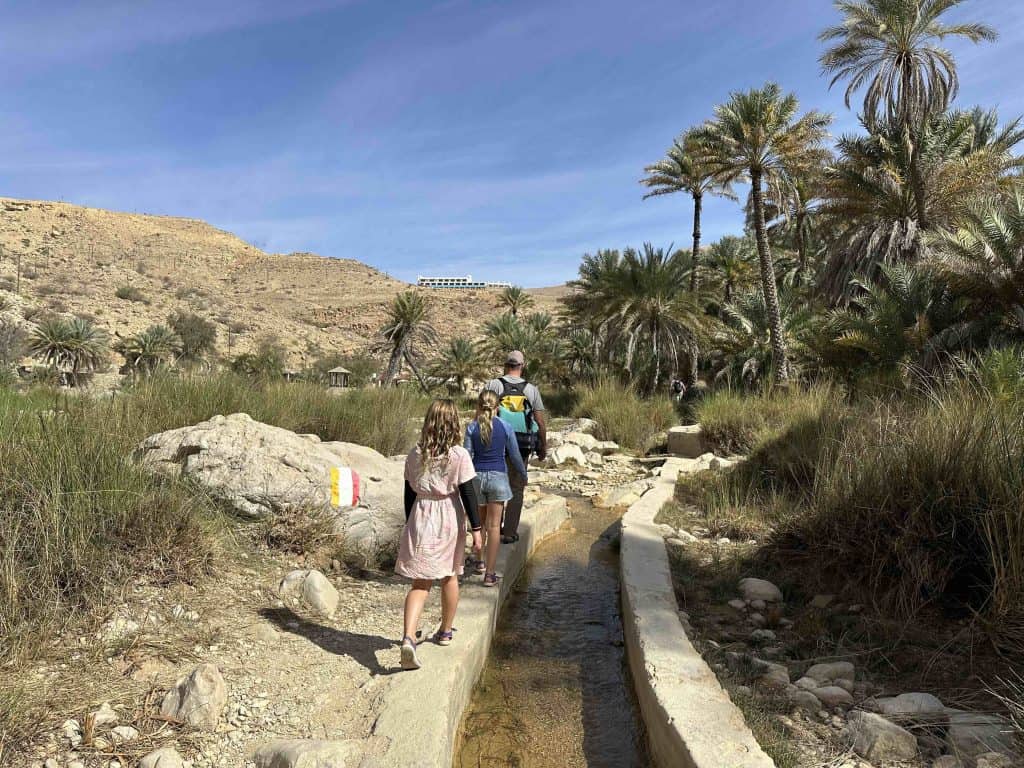
The wettest wadis have irrigation channels or ‘falaj’ tapping the water source for use in local villages and tiered plantations where you can find fruit trees and other crops growing.
Visiting wadis in Oman is popular with locals and tourists alike. They are a fun place to picnic, swim and hike. They are most busy on the weekends, so visit in the working week (Sunday to Thursday) if you want to experience their natural beauty without crowds.
Having said that, some wadis are much more popular and well known than others.
How many wadis are in Oman?
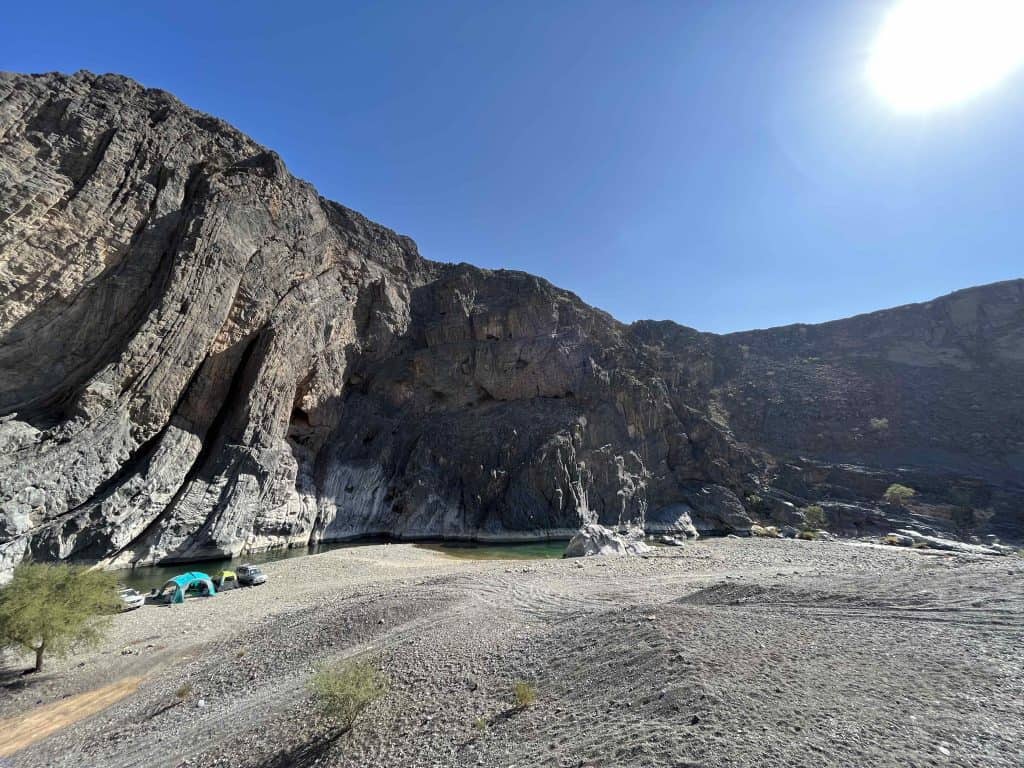
There are countless wadis in Oman.
The majority are in the north of the Sultanate due to the Hajar Mountain range from which hundreds of valleys stretch out to the Gulf of Oman and inland across the central plateau of the A’Dakhiliya Governorate.
In the south of the country, Dhofar is home to some of Oman’s most dramatic wadis which turn into lush oases during the monsoon season here.
How many wadis can you visit in a day?
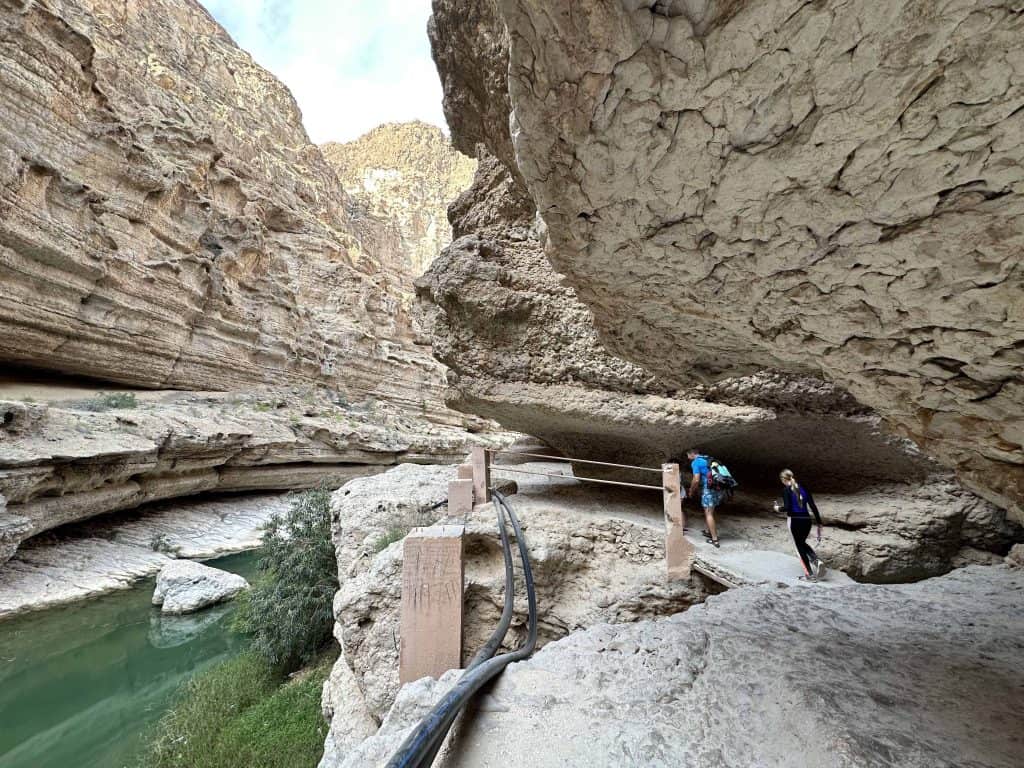
There’s no definitive answer to this question because, as I’ve already mentioned, wadis come in all shapes and sizes. We’ve spent between an hour and six hours at different wadis.
How many wadis you can visit in a day also depends on where you are travelling from.
I have seen it suggested that you can visit Wadi Bani Khalid in the same day as Wadi Shab and Wadi Tiwi. This might be possible if you were staying in Sur but it would be very rushed. You’d certainly not be able to hike and swim at them all, which is how you really experience these beautiful places.
And if you are based in Muscat, bagging these three well-known Oman wadis in one day would involve at least eight hours of driving without stepping outside your vehicle. So I’d not recommend it.
Read how you can fit all three of these must visit Oman wadis into a seven or ten day road trip.
Wadis in Oman
We have now visited a good selection of wadis, from little-known places that we’ve heard about from other expats to Oman’s most famous tourist spots.
Below is a list of the amazing wadis in Oman that we have been to. I’ve included variations on their names as you’ll spot these spelt differently on Google maps and road signs.
Scroll to the bottom of the list to find a map showing their locations in Oman. I’ll be adding to it as we explore more.
1. Wadi Al Khoud
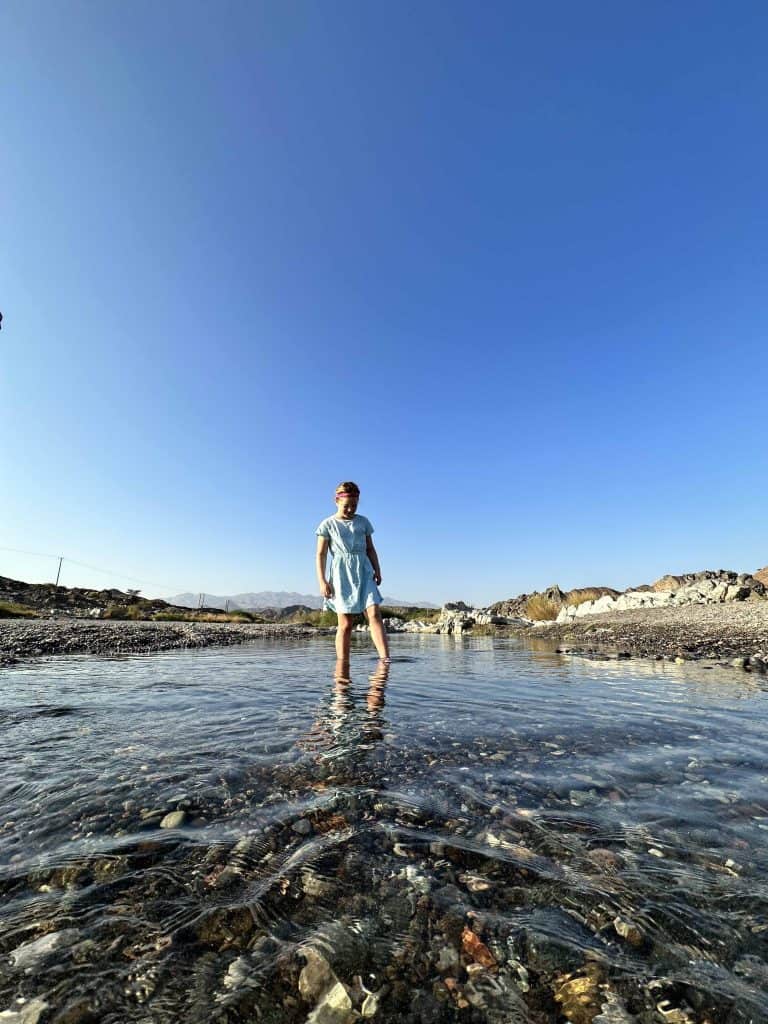
This was the first Oman wadi we visited and was a very easy introduction to wadi bashing.
The starting point for a hike at Wadi Al Khoud is less than half an hour from the centre of Muscat. There’s a car park at Al Khoud Village.
The wadi hike stretches inland on for about 20km to the village of Fanja and can be driven though with a 4×4.
It’s a particularly easy wadi to visit with children as there are shallow, shingle-filled rivers and pools where they can splash close to the car park.
If you want a longer hike there is a 6km trial marked from the village.
2. Wadi Bani Habib
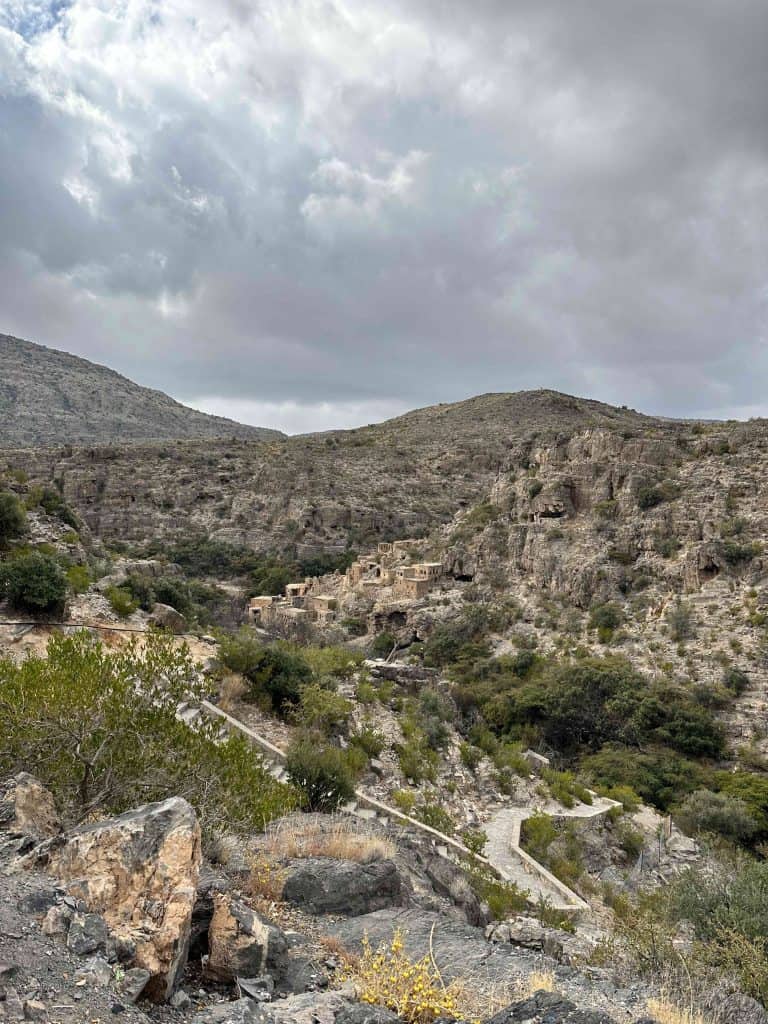
Wadi Bani Habib was our first experience of Oman’s mysterious abandoned villages in the Hajar Mountain range.
This one is on Jabal Akhdar, also known as the Green Mountain because of its lush landscape.
Bani Habib’s collection of crumbling mud dwellings clings to both sides of the valley where walnut and pomegranate trees grow.
From a very small car park at the top of the valley you descend a zigzag stair case to the wadi floor and follow a falaj through a plantation to the start of the old village.
It’s quite a challenge sticking to the green way markers that guide you around the ruins but absolutely worth it.
Wadi Bani Habib was inhabited until the 1980s when the lure of mains services proved too attractive to the villagers. Since then it has become a tourist attraction and is mostly safe to explore. It’s not maintained as such, so the mud buildings are slowly crumbling and the paths are steep and rocky.
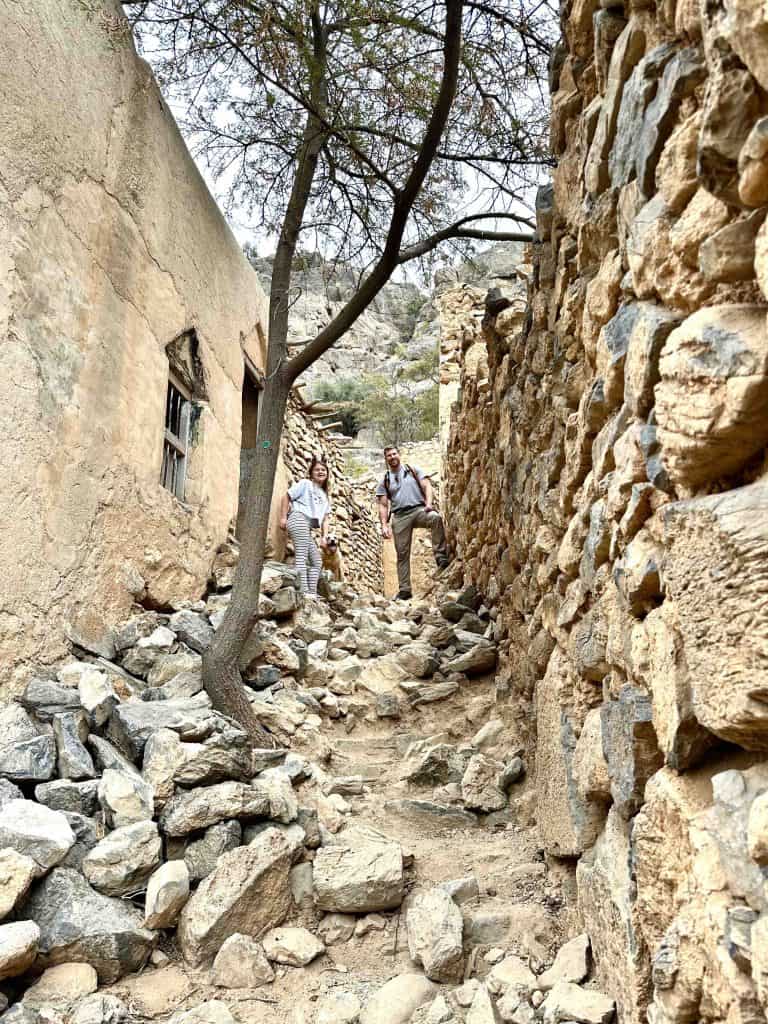
It’s best not to step inside any of the structures as there is a risk you’ll fall through a floor or something will fall on you.
Beyond the village you can continue up the valley for more mountain views and loop back around to explore the buildings on the opposite side.
There were no wadi pools in the valley when we visited in December despite recent rains.
3. Wadi Dayqah or Wadi Dhayqah
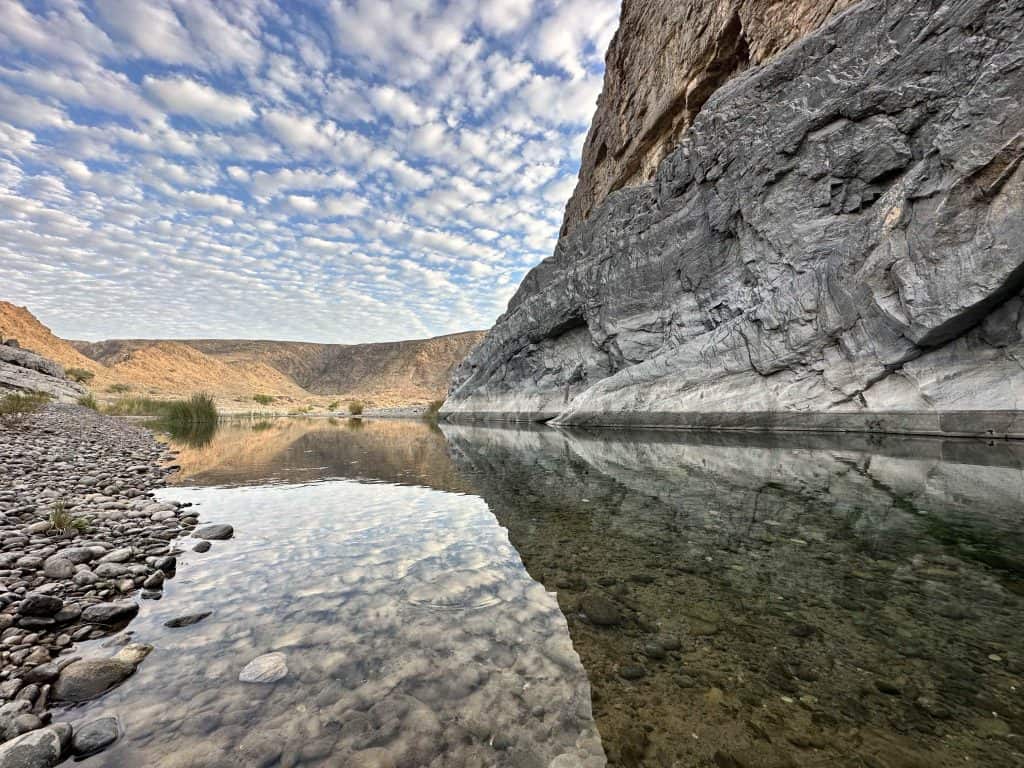
This beautiful spot in Wadi Dayqah was the first places we went wild camping in Oman.
A lot of people visit the Wadi Dayqah dam and reservoir south west of where we camped. The captured lake covers an area of 350 hectares. It is the largest reservoir in Oman and a popular view point, particularly at sunset.
We didn’t visit the dam but settled for a night in the valley below where you can hike and camp beside a river of turquoise water that slowly weaves its way towards the town of Qurayyat.
There are wadi pools filled with fish below folded cliffs and lots of shady spots. This makes it a good place for camping as you can escape the midday sun.
Here’s where to exit the tarmac road to park and start your hike or continue driving into the wadi:
A 4×4 is essential for driving into the wadi as you will need to navigate rocky off road tracks and water crossings.
4. Wadi Shab or Wadi Ash Shab
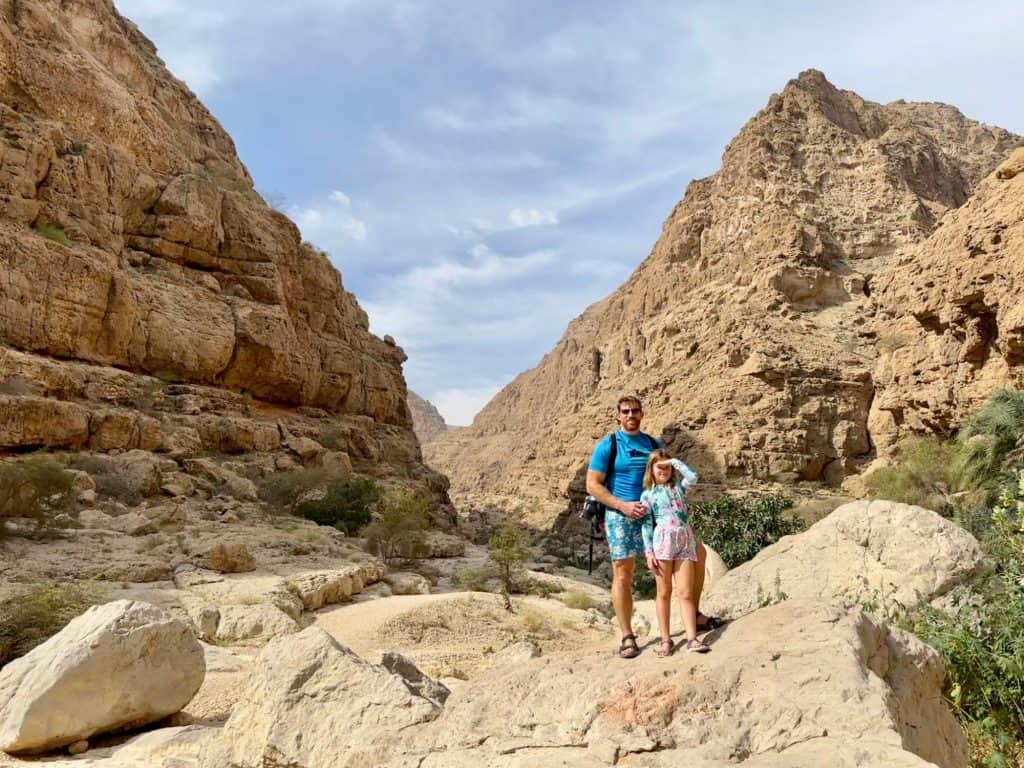
This is the most famous wadi on the road from Muscat to Sur and is well worth a visit.
Wadi Shab stretches out to the Gulf of Oman from Jebel Khadar in the south east of the Hajar Mountain range.
I’ll admit that I was a bit sceptical about it and how easily we could visit with our kids as we’d heard you can only see it all if you swim quite a distance.
We made sure we came prepared with buoyancy aids and we left our dog at home. She loves to swim, just not with us! We did see another family bring their small dog to this wadi. It looked like they are carrying it most of the way.
Visiting Wadi Shab starts with a boat ride across the wadi entrance to a trail on the other side of the the canyon. The ride costs 1 OMR per person, although we paid 0.5 OMR each for the kids.
You can visit the wadi and walk along a rocky path over the first pool without getting wet. Swimming is not allowed here.
After about an hour hike you reach the main pools where you can swim. It is not possible to progress further and see the rest of the wadi without getting wet.

At the very end of the swim there’s a hidden cave where you can climb a rope to jump back down into the pool.
Find more tips for visiting in my guide to Wadi Shab.
5. Wadi Tiwi
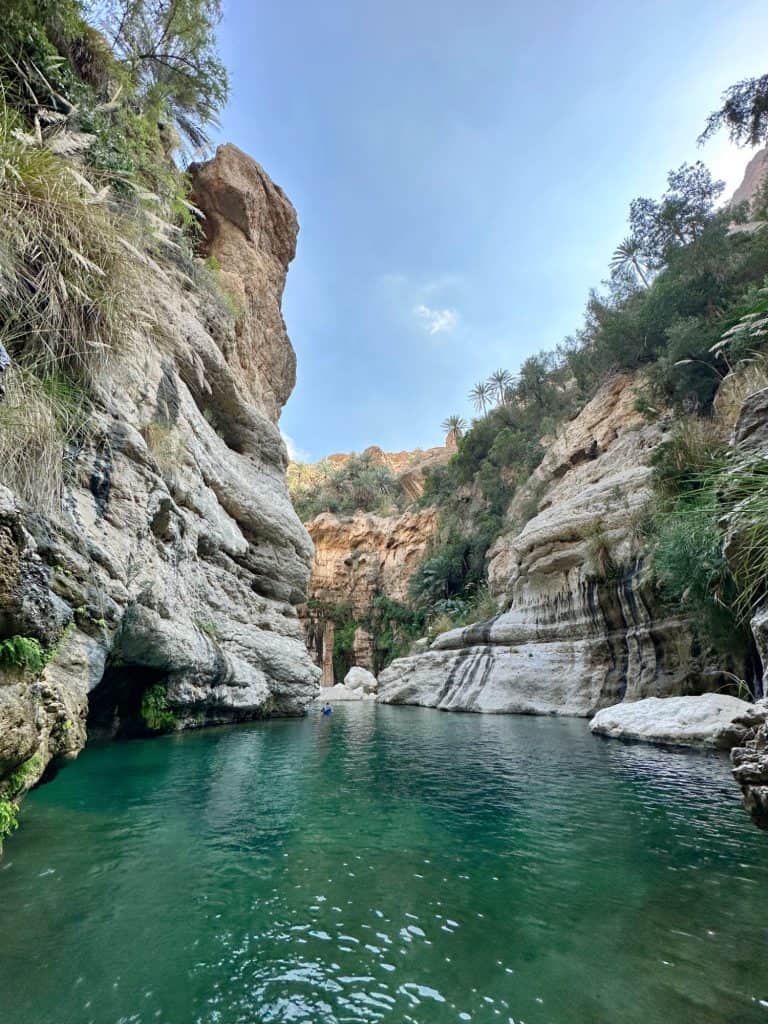
Wadi Tiwi is a stunning 36km canyon an hour and a half south of Muscat on the road to Sur. It’s not as well known as neighbouring Wadi Shab but it is just as stunning.
You can drive 10km into the wadi on a cement road peppered with green plantations that break up the rocky landscape and towering cliffs. You can also park at the wadi entrance and hike but this is not for the faint hearted as the route is exposed and steep in places.
The road winds up though the valley, passing through narrow villages and over sheer drops until you reach Mabim Village. This is the place from which to descend into the canyon to see the most beautiful pools and waterfalls.
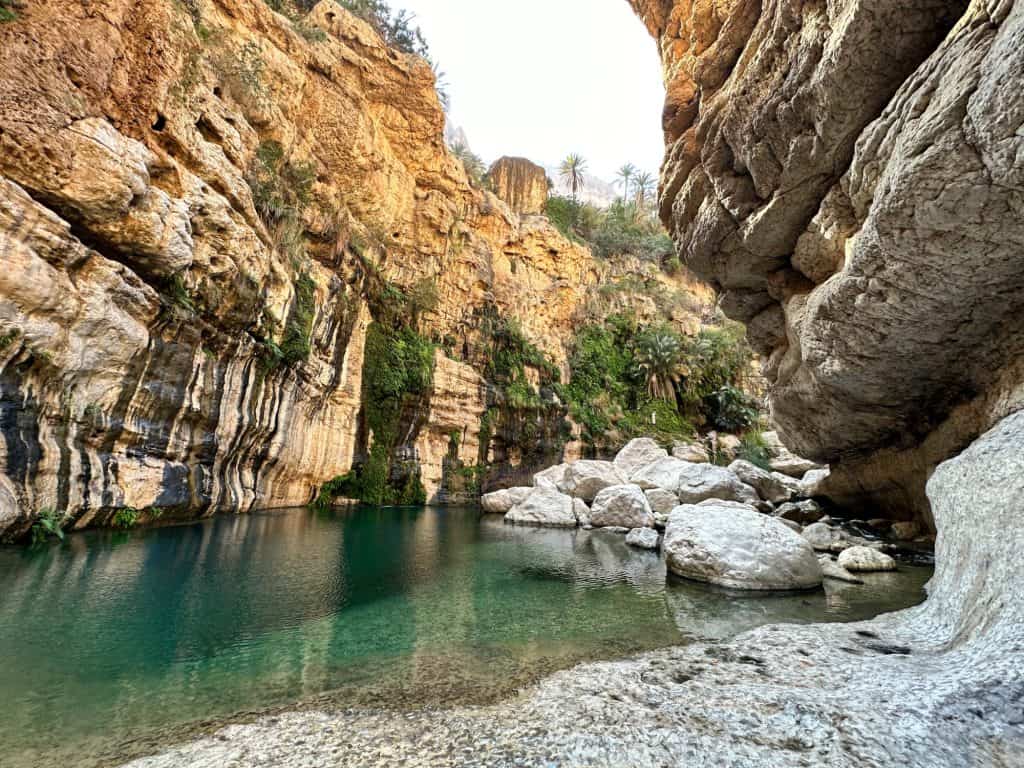
We skipped the long hike and used local guides at Mabim to help us reach the pools. You can also take a simpler route down a long set of steps at the far end of the village. I’d recommend doing this if you are visiting with young children.
I’ve written about both the guided and self-guided options in my post about visiting Wadi Tiwi with our kids and dog.
6. Wadi Bani Khalid
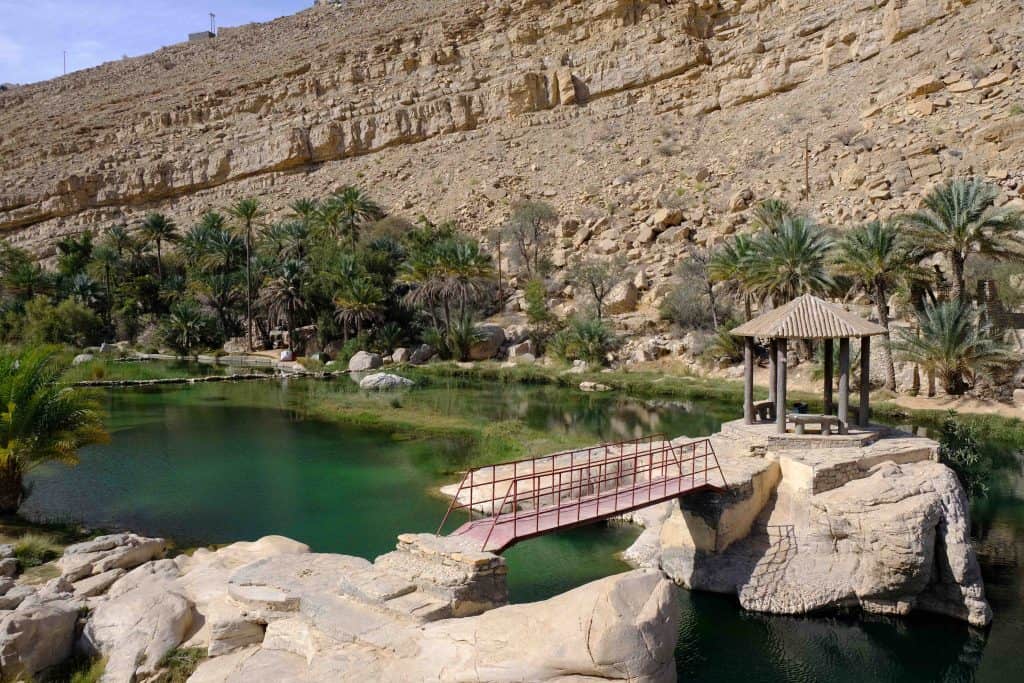
Wadi Bani Khalid is the most accessible and the most commercial wadi we have visited.
There’s mobile toilets and cafe in the car park and a restaurant beside the first large pool. You need to get here early, preferably before 10am to get a parking spot as this is when the guided tours start to arrive.
Mr Tin Box and our girls swam up and down the length of the wadi while I walked alongside with our dog.
One kilometre into the wadi is an amazing cave to explore.
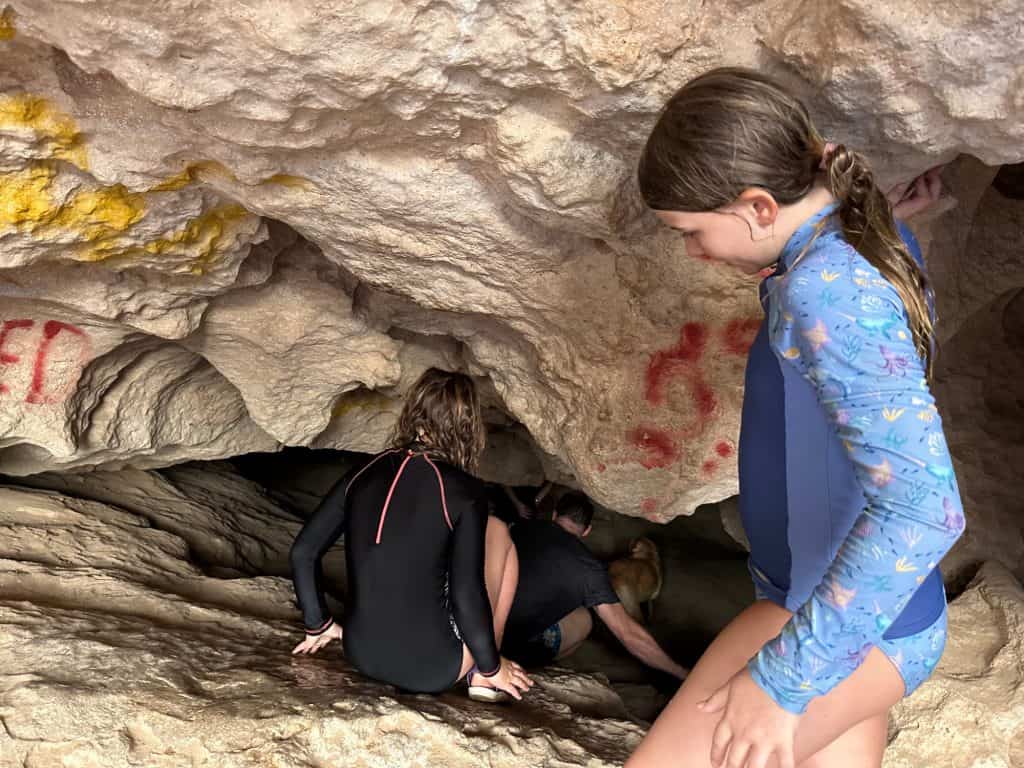
The narrow entrance to Muqal Cave gives way to small and then larger chambers where bats dangle from the honeycomb roof.
As we moved deeper we were hit by walls of hot air and the rushing noise of water further in. This hot spring feeds the pools of the wadi making them deliciously warm.
Read our full guide to visiting Wadi Bani Khalid.
7. Wadi Damm or Wadi Dham
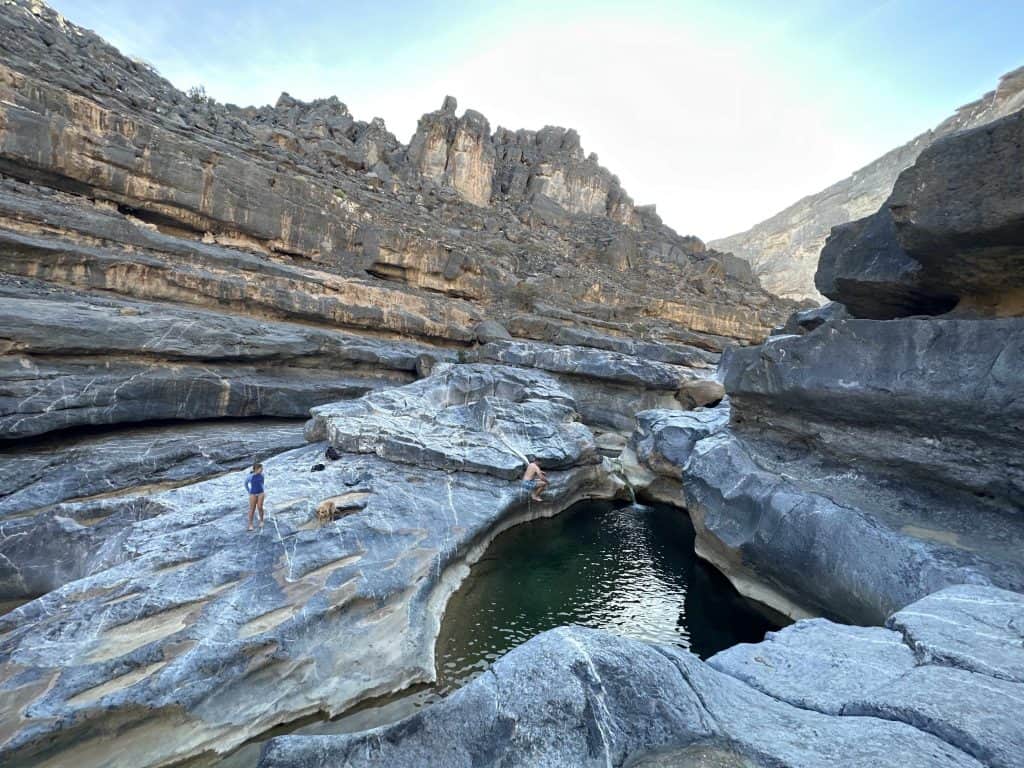
We visited Wadi Damm at the very beginning of a seven day road trip and it was a huge highlight for us. Check out our Oman itinerary in full.
As well as a challenging hike with incredible pools, you can see amazing petroglyphs – ancient artwork – scratched into the rock of the wadi walls in the parking area.
The rock art shows outlines of people, horses and camels.
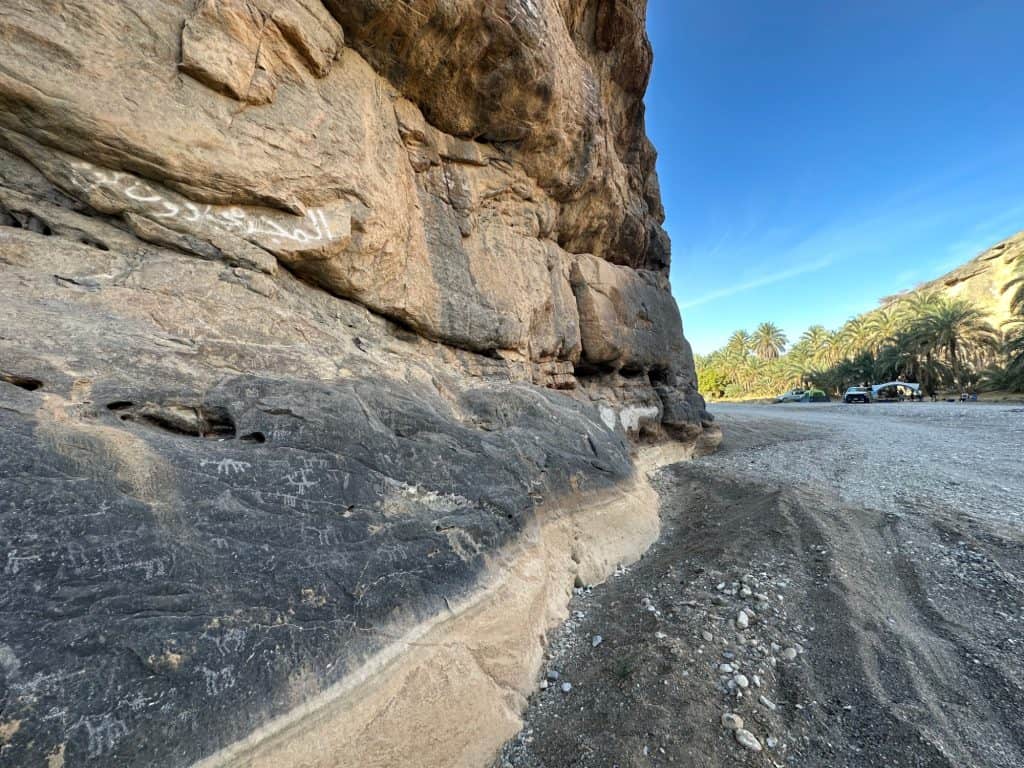
We spent six hours slowly walking to the main wadi pools and waterfalls, swimming in other magnificent lagoons and lunching in a cave on the way.
The path through the wadi is not very clear so we did some back-tracking to find the best route for the kids and dog. If you’re tackling this wadi as a group of adults you’ll probably progress much faster.
From the car park you walk into the valley and up a small set of steps over the dam. We followed our noses from here as there are no way markers. We had to slide down rock faces on our bottoms and scramble over rocks to reach the first two pools.
These were great for swimming and we’d not have been disappointed if our adventure stopped here. However it is possible to progress by climbing a rope through a narrow gap or up a waterfall.
We pushed our girls up through the gap but I didn’t fancy it myself. We’d heard there was an alternative path above the first pools so back tracked and found this.
After a lot more scrambling and sliding we found another set of pools that were like something out of a movie.

Water cascades over fern covered boulders to create warm showers that flow into turquoise lagoons.
If you visit Wadi Damm with young children the first set of pools beyond the dam are the best place to stop.
8. Wadi Hammam – an wadi in Oman with hot spring
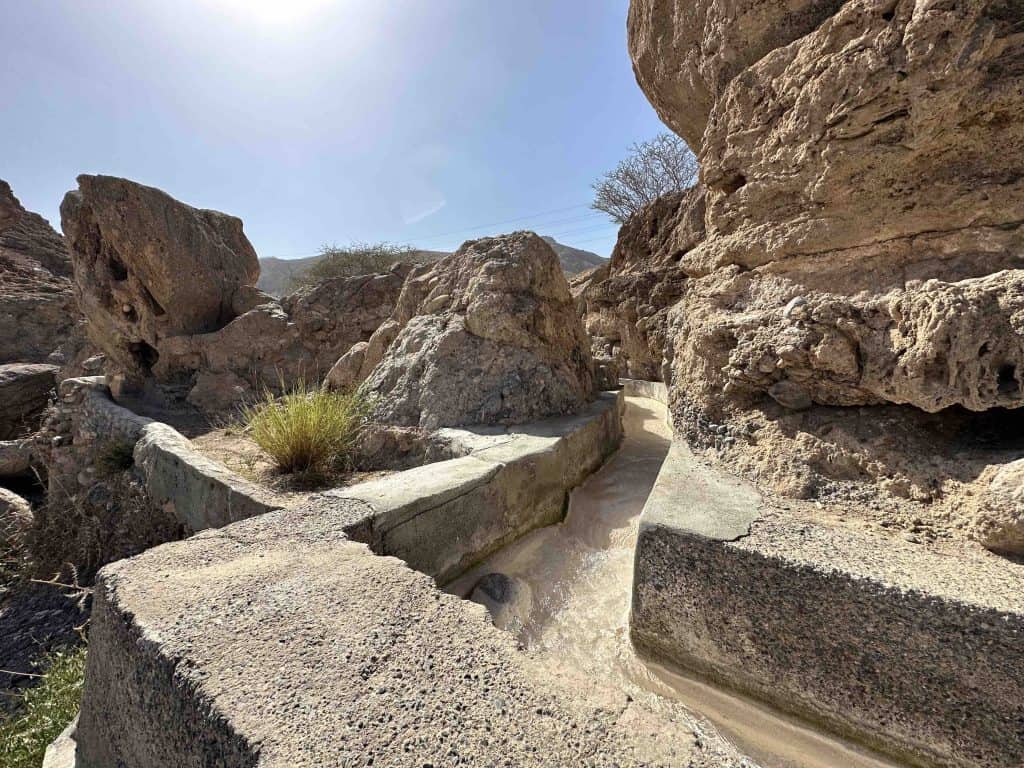
If you’re looking for a wadi near Muscat then Wadi Hammam is 25 minutes from the city centre. You’ll not find pools for swimming here but there is a fascinating hot spring, which is thought to be the hottest in Oman.
Warning: don’t touch or enter the hot spring water when you find it. There is a risk of getting burnt.
We parked in the village of Ain Al Hamam and followed the falaj system that we have become familiar with here in Oman. However, rather than cool wadi water it was channeling steaming hot spring water to a couple of bath houses in the village.
The source of the spring is concealed in some buildings beside the road into Ain Al Hamam about 500m away from the village.
You can cross this road and can continue a hike up the wadi. The valley is narrow and its necessary to climb over lots of boulders to progress.
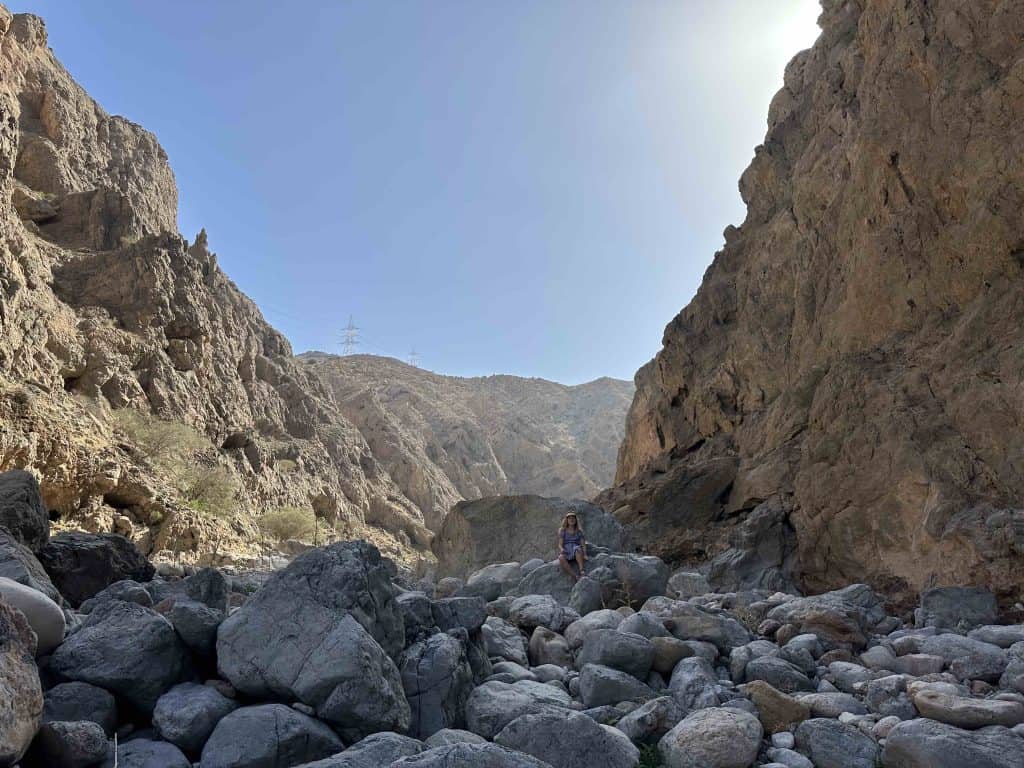
We didn’t get far on the day we visited as it was very hot. Wadi Hammam can’t claim the title of being the most beautiful wadi in Oman but it is easy to get to and the hot spring is intriguing.
Where to find these Oman wadis
Here’s where to find these wadis and my suggested starting points for visiting them:
More handy things to know about wadis in Oman and visiting them
We’ve learnt there’s a lot more to visiting Oman’s wadis than rocking up for adventure.
You need to do a bit of planning ahead. Here’s some of the tips we’ve picked up:
When is it best to visit a wadi?

The best time of year to visit wadis in Oman is between November and April when the weather is not too hot.
You’re also likely to find more water in the wadi pools in the north of the Sultanate in these winter months.
Ask any Omani when is the best time of year to visit the wadis in the south of Oman and they will say it is between June and August. This is monsoon season when the wadis around Salalah turn into green oases.
However, it is very wet, so if you’d prefer dryer weather visit between September and February when it is also less busy with holidaymakers from the Arabian Peninsular.
We find the best time of day to visit wadis is at the start of the day. This is before it gets very hot and you have a chance of beating the crowds if you visit on a weekend (Friday to Saturday).
However, I know some people like to see these beautiful places later in the day or at sunset when the ‘golden hour’ light is amazing.
If this sounds like you, I’d just share a word of caution about staying beyond nightfall unless you intend to camp. It can be hard to navigate rocky paths and wadi roads in the dark.
If you are visiting Wadi Shab you are also in danger of missing the last ferry back to the car park if you linger beyond 5pm.
Wadi safety
Visiting wadis is one of the most popular things to do in Oman but they don’t come with safety features you might expect at natural attractions in the UK and Europe.
You are responsible for your own health and safety.
Here’s some tips for wadi safety:
Be cautious around abandoned buildings
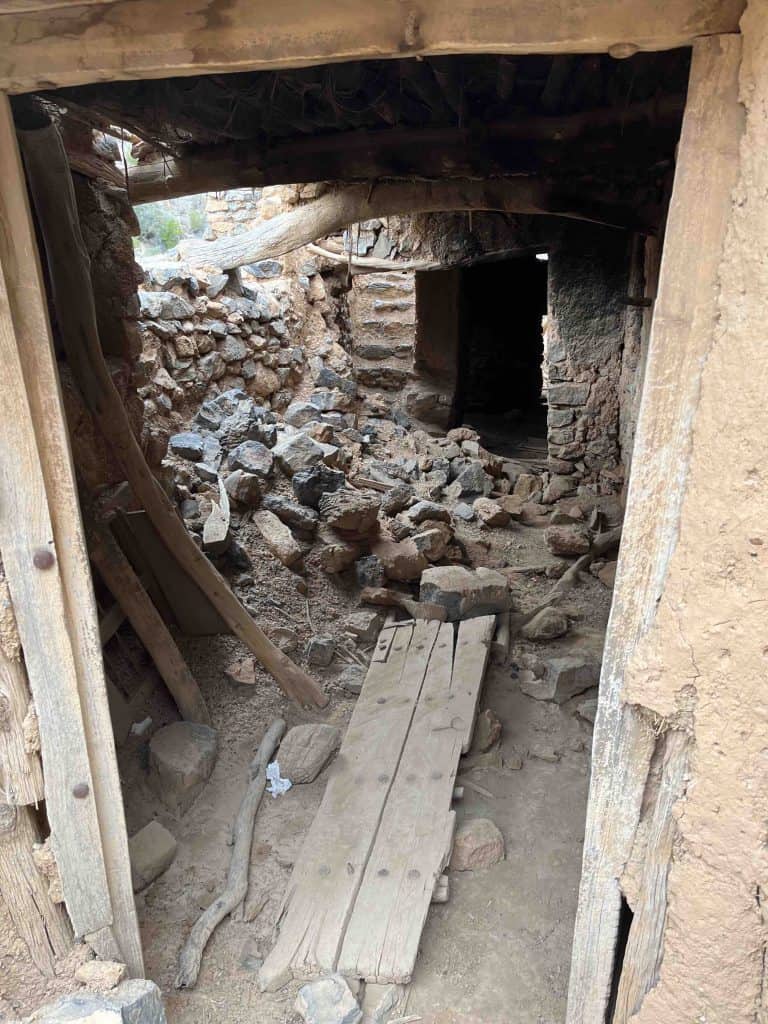
If you visit one of Oman’s abandoned villages you’ll find it very easy to step inside and explore.
But this doesn’t mean these structures are safe. In the UK similar places would be boarded up and fenced off.
Be careful, especially if you are visiting with curious kids.
Avoid visiting after rain
Yes, it rains in Oman. And when it does it can be torrential, which has a serious impact on roads and infrastructure in what is mainly a dry country.
If you’re from England, think ‘snow day’ chaos.
Importantly, do not to visit wadis immediately after it has rained as flash flooding can make them extremely dangerous.
Swimming in wadis
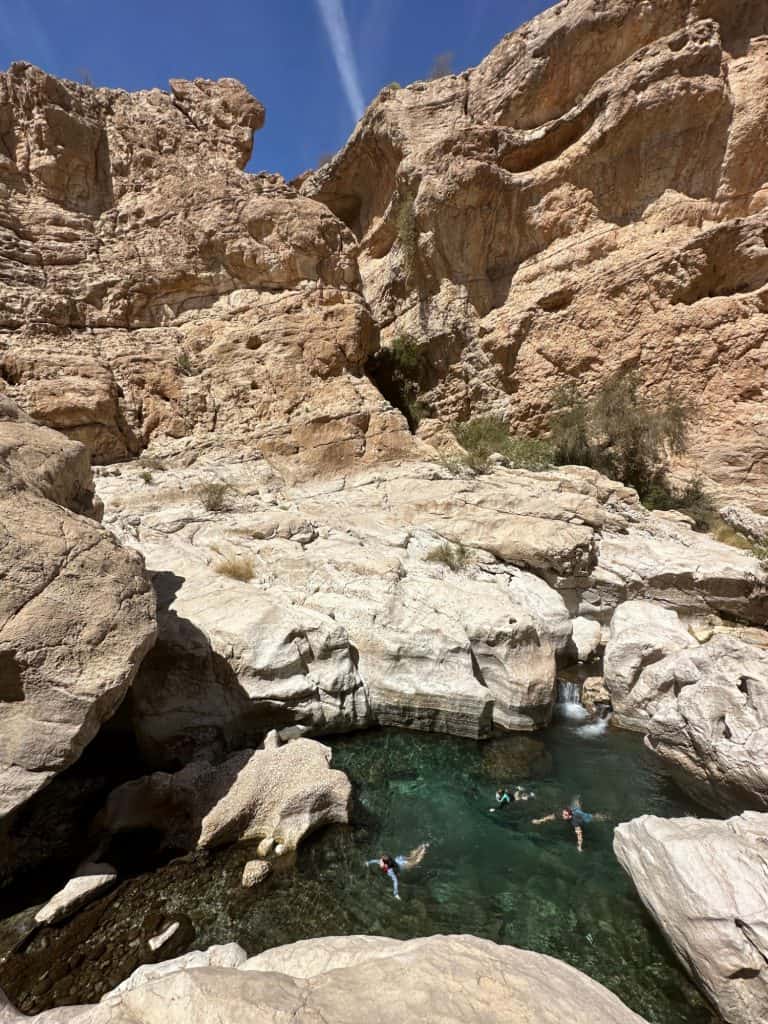
It is possible to swim in some wadis when the conditions are right. This is one of our favourite things to do at wadis. But it’s not always possible or safe.
Depending on whether there has been rain recently you might also find wadi pools are too shallow or have dried up altogether. Test water depth before jumping!
When you do visit a wadi where there is enough water to swim its advisable to wear a buoyancy aid. You can quickly get out of your depth in natural pools, which can be dangerous even for strong swimmers.
Take a look at my list of what to wear and other things to bring with you for more wadi safety tips.
What to wear at wadis in Oman
Oman is a Muslim country where dressing conservatively is a legal requirement. In general you should wear clothes that cover upper arms and knees.
Swimwear should also be conservative. You may look hot in a bikini or thong, but locals could be offended by the sight of too much flesh.
If, like us, you travel to experience different places and cultures without wanting to upset anyone, here’s some tips on what to wear at wadis in Oman:
For woman
I wear a short sleeve t-shirt, cropped walking/yoga leggings or light walking trousers and walking shoes that I can use in water. Walking sandals would also work but I prefer footwear with closed toes for hiking on rocky trails.
This kind of outfit meets local clothing expectations as well as being comfortable for what can often be quite strenuous activity.

If you’re in the Hajar Mountains in December or January you’re going to need long sleeves too because it’s much cooler at altitude. We got caught out during our first visit to Jabal Akhdar when we’d wished we’d brought jumpers.
When it comes to the swimming I’d recommend rash vests with short sleeves* and swim shorts*. These can be worn underneath other clothing and help to protect you against the sun.
I have also swum in my workout leggings and a t-shirt but try to avoid this if there’s a long walk back to our car.
Hats and scarves (they make versatile cover ups) are also optional items you might want to bring.
For men
Mr Tin Box wears a t-shirt, long shorts or light walking trousers when we are at wadis.
He doesn’t always cover his knees, particularly at wadis that are more touristy like Shab and Bani Khalid, but this seems to be less of an issue for men during outdoor activity.
However, short shorts and speedos would raise some eyebrows.
Again, rash vests* and swim shorts* are more in keeping with local clothing expectations when swimming.
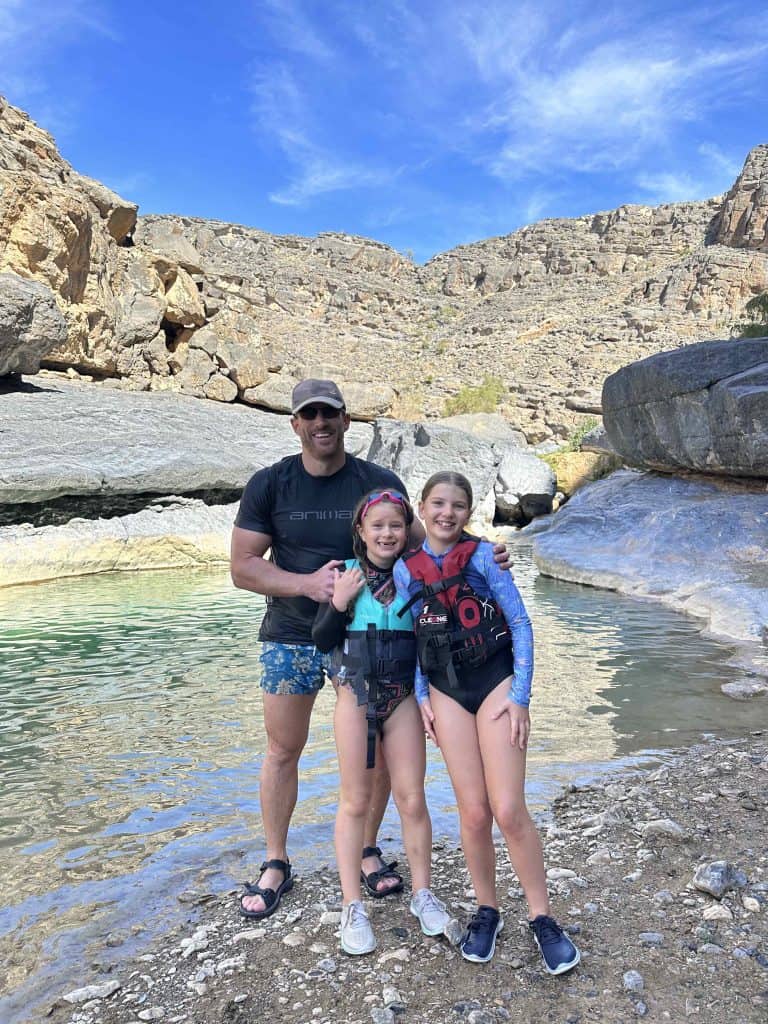
For kids
What kids wear at wadis doesn’t matter as much as it does for adults. However, for practical reasons in the hot, sunny weather we usually put our girls short or long-sleeve t-shirts and leggings.
They have KEEN walking sandals* which they can continue to wear in the water to give them some extra grip and protect their feet. We’ve also bought Croc water shoes for when they need closed toes.
For swimming they have long sleeve swim suits that protect them from the sun.
Buoyancy aids
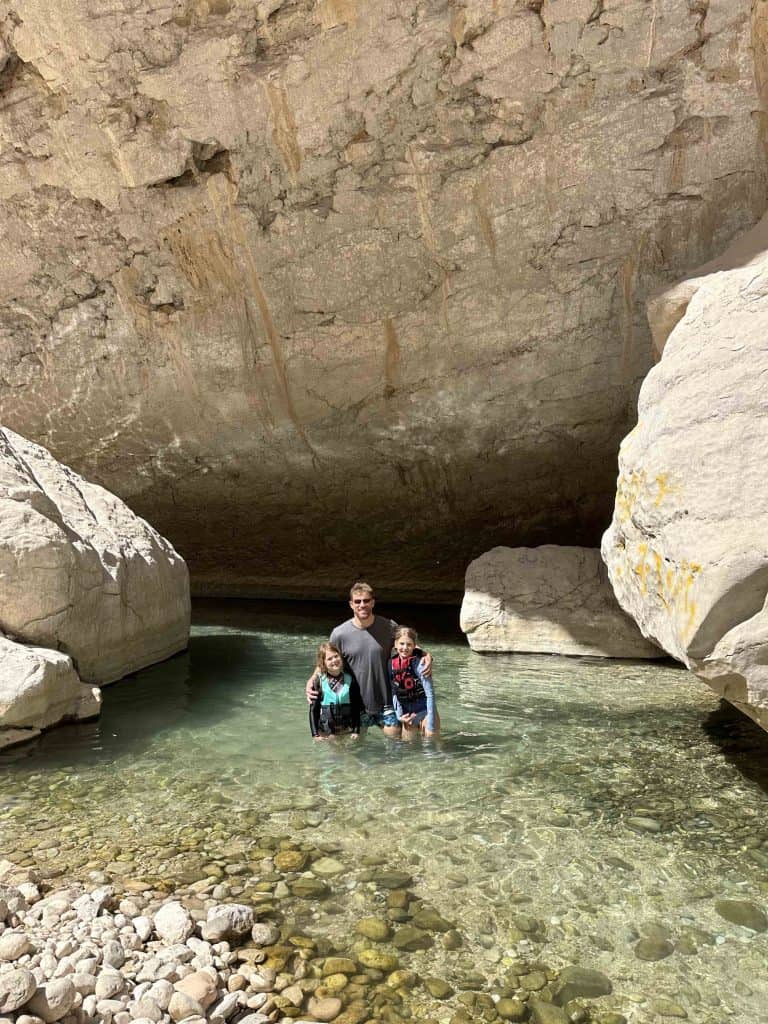
Your health and safety is your own responsibility whichever wadi you visit. This is why we started bringing along buoyancy aids to every wadi where we intend to swim.
Accidents can happen quickly, particularly slip ups. So if you fall over in water it’s much better that you float.
We brought one of the kids’ buoyancy aids with us from the UK and bought another at Decathlon in the Mall of Oman in Muscat where they also sell adult buoyancy aids.
Other things to take to a wadi
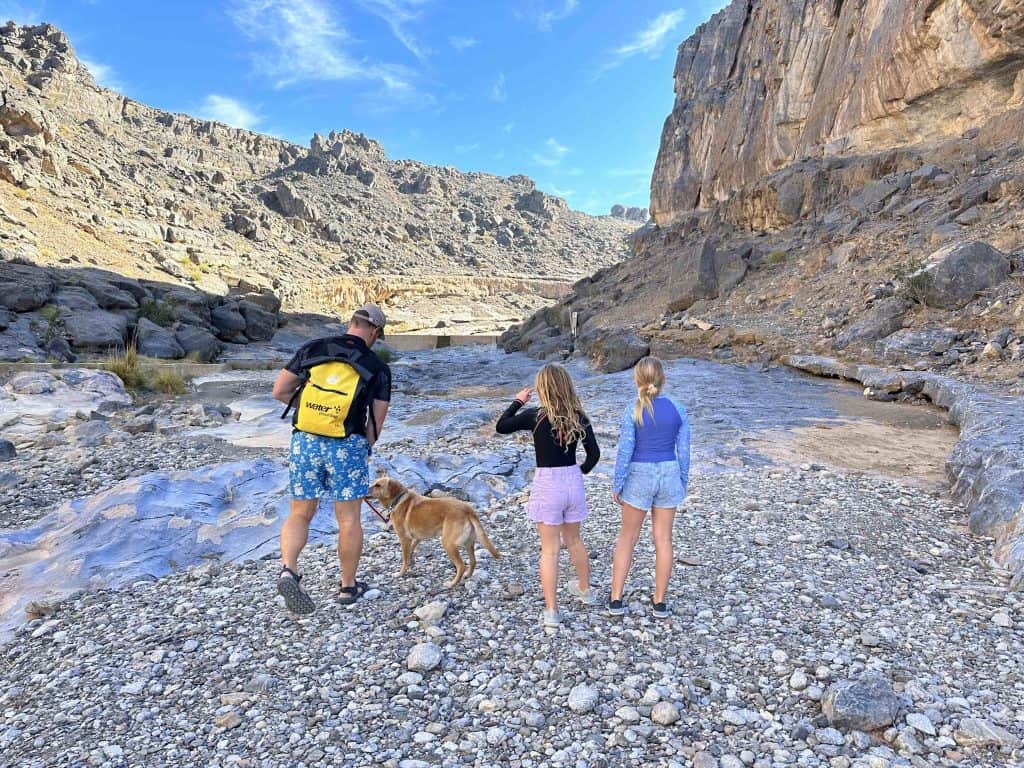
After visiting several wadis in Oman we’ve put together a list of suggested things to take along.
We’ve kicked ourselves a few times for forgetting obvious things and items that make the experience so much easier. But I think we’ve now got the definitive list.
If you don’t already have some of these essential items we’ve found the following shops good for outdoor gear:
- The Sultan Centre, various locations in Muscat
- Decathlon in the Mall of Oman in Muscat
- Sun and Sand Sport in Avenues Mall, the Mall of Oman and City Centre Mall in Muscat. There’s also an outlet shop in Markaz Al Bahja.
I’ve also included links below where you can order these things online if you’re able to plan far enough ahead.
Here are some wadi staples to bring with you:
Dry bag
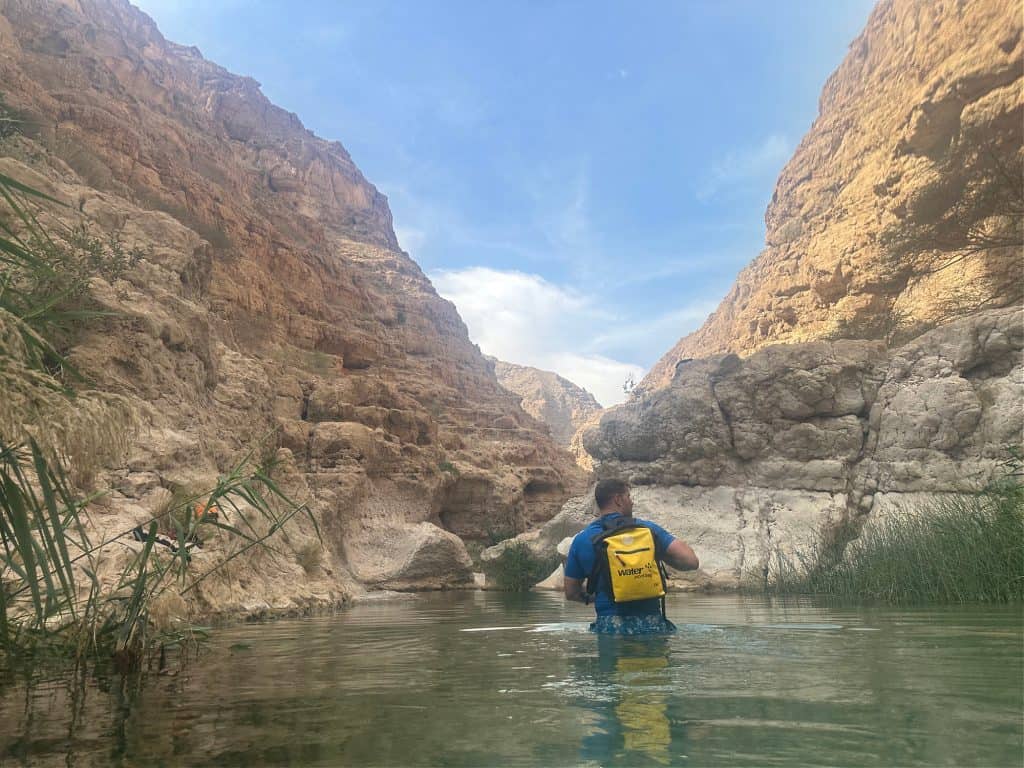
We have a rucksack that’s also a dry bag. We picked this up at a Sultan Centre shop in Muscat and we take it with us everywhere now.
It’s easy to carry and big enough for a light-weight towel, some snacks and water, goggles for the kids, and a first aid kit. It also doubles as a useful flotation device. We use it when paddle boarding too.
You can buy it online*.
Towels
Bring a microfibre towel*. It’s a good idea to dry off a bit when you leave the pools so you are less likely to slip on the way back to the wadi entrance.
You need something small that won’t retain lots of water and become heavy.
Sun glasses
There’s lots of shade to be found in the wadi but not all the time so protect your eyes with good sunglasses.
Sun cream
For exactly the same reasons as you need sunglasses, wear factor 50 sun cream on your face and body. Even in the shade you’ll be picking up rays.
Goggles
I’m not a fan of putting my face in the water intentionally but my kids love it. Goggles allow them a different perspective on wadis so we always bring theirs.
Change of clothes
In case you get your clothes wet or dirty leave a spare set in your vehicle.
Snacks and water
Where would us parents be without snacks for the kids?! Our go to snacks for hiking trips are apples and small packets of biscuits, which we can easily slip into our rucksack.
We often pack a picnic too as it means we can get food into the kids fast when we get back to the car. A cool box and ice blocks are handy for keeping food fresh in a hot vehicle.
Water
You’re going to need a lot of water, but won’t necessarily want to carry it all with you.
Make sure everyone has a small bottle of water for the hike and leave some chilling in your vehicle.
Tissues
I don’t go anywhere in Oman without a packet tissues. You never know if public lavatories will have any, especially in more rural areas where squat toilets and bum guns (hoses by the loo) are the norm.
First aid kit
Something else we rarely adventure without is our small first aid kit. This has plasters, including Compeeds, bug bite cream and Panadol (paracetamol). This is what we carry with us.
We have another first aid kit* including bandages in our car.
Head torch – optional
If you’re visiting a wadi with a cave, like Wadi Bani Khalid, it’s a good idea to bring a head torch* to help you explore.
More reading about Oman
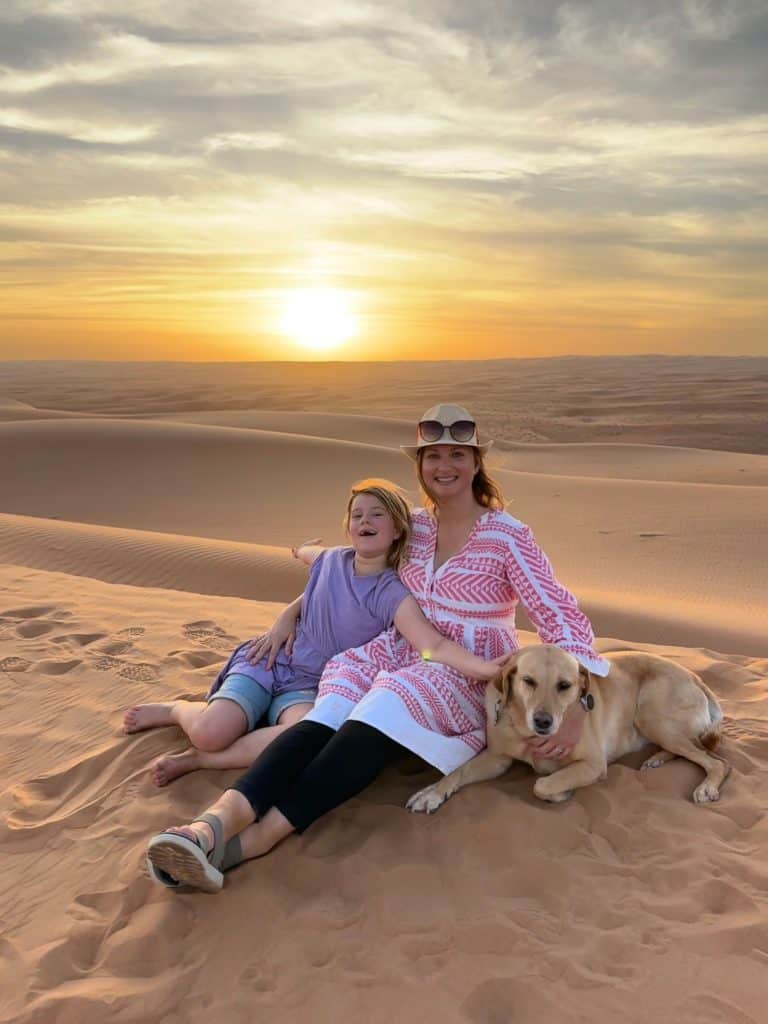
We moved to Oman in 2022 and are loving getting to know our new home.
Here’s some more posts I’ve written about Oman and expat life:
Check out the #TinBoxOman hashtag on Instagram to see more of our adventures.
Have you visited any wadis in Oman? We’d love to hear your recommendations on where we should visit next.
Disclosure: this post contains affiliate links marked with *. If you click on one of these and make a purchase I may earn some commission. This does not affect the price you pay.


